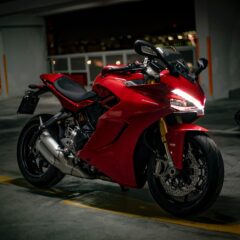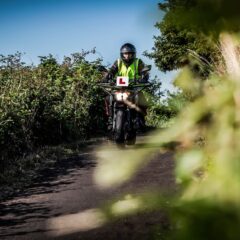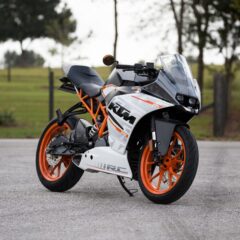
7 Top Motorcycle Accessories
With Christmas just around the corner, you might be wondering what to get your favourite motorcycle enthusiast or even a little something for yoursel...
 Phoenix Motorcycle Training LTD
Phoenix Motorcycle Training LTD
 Phoenix Motorcycle Training LTD
Phoenix Motorcycle Training LTD

It’s not difficult to stop on a motorcycle. They have fantastic brakes. But braking while maintaining control can be a little more difficult. You need good working habits and trust in your motorcycle braking technique. We’ve already covered the physics of good riding, and turning techniques. It’s time to turn our attention to confident braking.
A correct braking technique stops your motorcycle effectively, stably and reliably. Motorcycles are equipped with excellent brakes, both front and back. In most cases, the front brake acts as the main brake. It can usually stop the motorcycle on its own.
However, when a passenger or luggage is on the back, both front and rear brakes may need to be engaged simultaneously to make a controlled stop. That’s why you need to trust your braking technique and practice it until it becomes second nature.
The front brake of a motorcycle is the main brake. A lot of riders are scared of the front wheel locking up. It can happen when learning to use the brake properly. If the wheel does lock, all you need to do is ease off on the brake a little to let the front wheel spin again. Your motorcycle will stabilize and you’ll have learned something new.
Rear wheel locks are a lot more serious than the front wheel locking. When the rear wheel locks, it can cause the bike to slide. Using both front and back brakes together is an important skill that should be mastered.
If you ride a motorcycle with a front brake that can handle stopping your bike, this should be your go-to stopping method. On the other hand, if you have a motorcycle with mediocre brakes or a lot of weight over the rear wheel — touring bikes and motorcycles with passengers or luggage for example — mastering both brakes in combination is necessary.
Your riding position on a motorcycle has a big impact on braking. Straightening your back and stiffening your arms as you brake is a natural tendency that can cause problems. It destabilizes the motorbike by transferring weight up the front wheel, inviting a rear wheel lift.
Instead, anchor your feet on the pegs. Knees and thighs should hug the fuel tank. Your leg, stomach and lower back muscles should hold your body back. Keep your arms loose and relaxed. Where you look also influences your braking. Keep your gaze level and look far ahead.
This rider position feeds the braking inertia further back and lower down into the bike, increasing the stability and ensuring the rear wheel keeps in contact with the road. It’s much better for your front suspension too. When you do it right, you’ll be able to sit balanced on your bike after it stops and rises on its forks. Once this has happened, place one foot on the ground for stability.
Effective braking is the result of reaching your brake’s full capacity smoothly and quickly. Don’t be timid with your front brakes, but don’t yank on them either. Instead, apply pressure smoothly and determinedly. Don’t waste time braking meekly. Your motorcycle moves at 13.5 metres per second when you’re travelling at 30mph! That’s roughly the distance of two car lengths.
This smooth and determined action compresses the front suspension in a controlled way. That leads to smoother and safer riding.
Grabbing the brake too powerfully causes the front suspension to “bottom” and the wheel is likely to skid and stomp. To know exactly how smoothly and how quickly you need to do this takes practice. It will vary depending on the situation, so pay attention and practice consciously.
Rear motorcycle brakes need a slightly different technique. They’re generally a little more difficult to regulate. Whether or not they lock up is determined by a couple of factors; how hard you brake and how much weight is transferred to the front wheel. Your rotating rear wheel provides stability to your motorcycle when moving and braking.
Engage your rear brakes in tandem with your front brakes. When done correctly, it keeps the inertia low and towards the bake, maintaining stability. The amount of pressure will vary depending on the load you are carrying. The effect can be considerable, so the only way to know the exact amount of pressure is through practising with and without luggage, with and without passengers.
It’s best to leave the rear brake alone when riding through a curve. The risk of sliding out is considerable. When applying the front brake on a curve, you’ll notice the motorcycle tends to straighten out. Steering becomes heavy and it feels like it wants to go straight.
To keep your motorcycle on course while braking around a curve, you must brake and countersteer at the same time. This is the most efficient, and safest, way of braking in a curve.
You should also relieve the handlebar pressure when you achieve a lower speed. If you don’t you risk the bike falling.
Reading about motorcycle stopping and braking techniques is very different to trying them on the road. Below are three exercises to practise your motorcycle braking technique and become a better rider.
Practise using your front brake only in all speed-reduction situations. Consciously move your hand and fingers to the brake. Ensure your rider position has your lower body anchored and hugging the bike. Your arms should be loose and relaxed, eyes looking ahead. This brake preparedness is essential for safer, faster and smoother braking.
Smoothly and firmly apply brake pressure. Try braking a little later than usual when approaching a familiar curve. Make gradual adjustments, ensuring you are always in control of your machine. When bringing your bike to a complete stop, be alert and keep your gaze level and pointed ahead. Make sure your motorcycle is in complete balance and once at a complete stop, place your foot down.
Become familiar with the rear brake. Experiment with the amount of pressure needed to apply in different situations to make the rear wheel lock. Do this carefully and incrementally. When the rear wheel locks, let up on the brake and notice how it feels. This should be done with caution and care.
Learn the difference in feel between rear wheel locks on wet and dry roads, tarmac and gravel. Be conscious of your rear braking. Practise consciously until you feel confident and secure applying rear brake pressure.
Combine front and rear brakes. Notice the timing of each brake — the back locks earlier when you apply the front brakes at the same time. Maintain focus first and foremost on the front brake. Try applying the correct pressure on the rear brake at the same time as the front.
In most cases, you should use the front brake alone. This gives you one brake to focus on and is a safer option when the motorcycle’s front brake is capable of halting the bike on its own. Learning how to use this effectively should be your priority.
Riding a motorcycle efficiently, safely and effectively takes practice. Each ride gives you to opportunity to do this, whether it’s your motorcycle steering technique, acceleration or braking efficiently. Each ride will provide new opportunities to learn and become better.

With Christmas just around the corner, you might be wondering what to get your favourite motorcycle enthusiast or even a little something for yoursel...

If you love motorcycle riding, you’ve probably daydreamed about riding a motorbike for a living. A professional racer or stunt rider is OK for some...

Getting a UK motorcycle licence can seem a complicated process. Particularly when compared to a driving licence for a car. Whether you choose the pro...
This website uses cookies to personalise content, ads, and analyse traffic, sharing data with partners who may combine it with other information. See our Privacy Policy for more information.